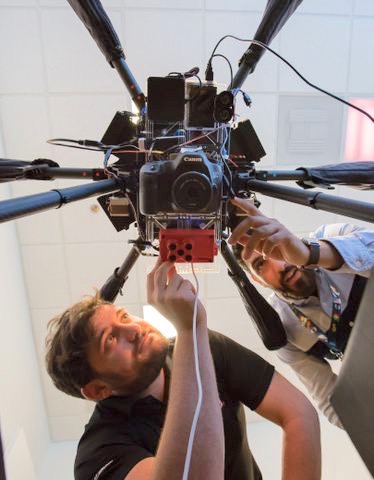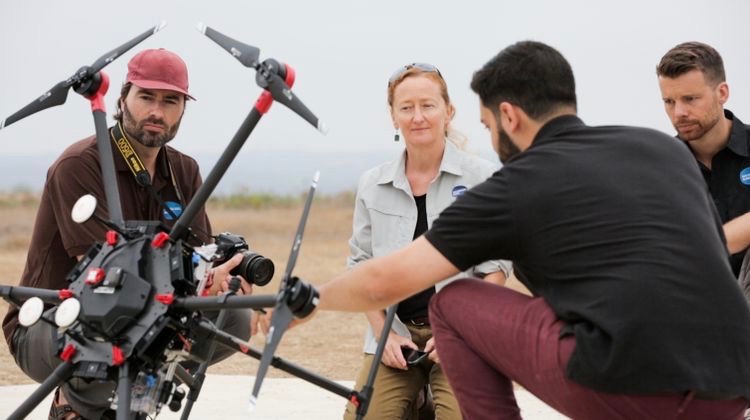Daily Business Report-Oct. 30, 2017
The USS Carl Vinson. A key driver of the growth is a steady rise in the number of Navy ships based here, from 40 in 2015 to 64 in the current fiscal year.
San Diego’s Military Economy
Reaches $50 Billion Annual Milestone
The military remains San Diego’s largest single economic sector, supporting 338,000 jobs and and reaching the $50 billion milestone in the most recent fiscal year.
The San Diego Military Advisory Council’s ninth annual report on the region’s military economy, released Friday at a press conference at Naval Base Point Loma, painted a picture of steady growth despite the vagaries of funding from Washington.
“The numbers are truly impressive in terms of the scope, the size and the synergy,” said Dr. Lynn Reaser, chief economist at Point Loma Nazarene University. “The military far and wide remains San Diego’s most important economic driver.”
The military — including the Navy, Marines, Coast Guard, Homeland Security and Veterans Administration — is the region’s largest employer. One out of every six U.S. Navy sailors and one out of every four U.S. Marines receive their paychecks in San Diego.
Federal military spending in the region is expected to increase by 3.8 percent in the 2018 fiscal year, which began Oct. 1, compared to 3.2 percent in the previous year.
A key driver of the growth is a steady rise in the number of Navy ships based here, from 40 in 2015 to 64 in the current fiscal year.
Rear Adm. Yancy Lindsey, commander of Navy Region Southwest, said ships are being moved here because San Diego is the “stepping off point to the Pacific” — the world’s leading economic region — and the nearby cluster of air, sea and land training areas is unmatched.
He said 72 ships are expected by 2025, with more possible if the rate of ship building is increased. “First of all, we need a larger Navy,” he said.
Rep. Susan Davis, a member of the influential House Armed Services Committee, said that while she was pleased with the economic impact, she was most concerned about supporting the men and women who serve.
“What’s really import is the men and women who serve our country and call San Diego home,” she said. “We have food insecurity among our military families; the cost of housing is a tremendous challenge.”
She promised to address both of these issues in Congress.
Though defense funding has been covered by a continuing resolution instead of a formal Congressional spending bill for the past three years, Reaser said the outlook for San Diego remains strong.
“San Diego has been weathering these storms for a long time now,” she explained.
___________________

Northrop Grumman and San Diego Zoo Global
Bring Next-Generation Autonomous
Flight Technology to Arctic
San Diego Zoo Global scientists and Northrop Grumman Corporation engineers are in a unique collaboration to advance the understanding of sea ice dynamics in a changing climate and impacts on polar bear behavior.
Now in year two of this effort, the team spent 2016 testing and validating autonomous flight technology, to better understand the performance of unmanned aircraft systems (UAS) in remote areas with extreme weather conditions. For their upcoming November 2017 mission — Operation #PolarEye — the team is bringing new technology to San Diego Zoo Global’s conservation efforts that could allow scientists to collect critical data using a new habitat monitoring system.
“There are few studies of polar bears based on direct observation. With the development of this autonomous system, we are hoping to gain a perspective into polar bear lives rarely seen before,” said Dr. Nicholas Pilfold, scientist in population sustainability at the San Diego Zoo Institute for Conservation Research. “This data will ultimately help inform conservation strategies for the species.”

Since the late 1970s, scientists have used satellite imagery to evaluate sea ice habitat that is critical to polar bear survival, and they have used a wide range of methods to study polar bears in their habitat. Though it is highly valuable, satellite imagery has limitations; and traditional research methods can require handling of polar bears, with studies of behavior dependent on direct observation—which is rare and can be dangerous for researchers. The autonomous system will be utilized to provide a more detailed, finer-scale view of sea ice habitat, and it offers the potential to observe polar bears without disturbing the animals or posing a risk to humans.
“The latest, innovative technology can have a significant impact on this program,” said Charlie Welch, Northrop Grumman’s technical lead for Operation #PolarEye. “We are using new techniques in prototyping and rapid product development to deliver a system scientists need to better understand ice pack and polar bear behavior.”
___________________

San Diegan Wins SBA’s
InnovateHER Competition
San Diego resident Jenna Ryan won the Small Business Administration’s national InnovateHER competition in Washington D.C., beating out 10 finalists, following regional competitions across the country. Ryan won $40,000 from the Sara Blakely Foundation to scale her business that improves the lives of women — a preventative health drink called Uqora.
Ryan’s Uqora gives women the defense they need against bacteria that causes urinary tract infections, keeping them out of the doctor’s office and off antibiotics.
The annual InnovateHER competition was designed to support businesses that create products that improve the lives of women and families. Uqora is a citrus-flavored drink mix that has been found to reduce incidents of urinary tract infections (UTIs). UTI’s are the 2nd most common infection in the US.
Ryan participated in the regional InnovateHER business pitching competition held at Hera Labs business accelerator in Sorrento Valley, before advancing to the finals in DC.
___________________

Encanto Mixed-Use Project
Gets Green Light from Civic San Diego
The Encanto community will soon be home to a $44 million mixed-used development at Hilltop Drive and Euclid Avenue.
The Civic San Diego Board of Directors recommended to the City Council to grant Affirmed Housing Group an agreement to develop the 8.5-acre city-owned site, which will include 44 single-family homes for sale at market rate, 111 affordable housing units available for rent, and 8,485 square-feet of retail space.
32 North Brewing Co proposes to open a full service sit down restaurant, brewpub and coffee shop on site — and plans call for 1.9 acres of open space with trails, parks and public art.
The overall design is cyclist and pedestrian-friendly, as it has many paths that connect to a bridge that overlooks an arroyo.
Construction is slated to begin in summer 2018.
___________________
General Atomics Forms Partnership
with University of Mississippi
General Atomics has partnered with the University of Mississippi on a project to build acoustic-based navigation and sensing technologies for unmanned underwater systems designed to aid deep-sea operations.
The company’s electromagnetic systems group will work in UM’s Insight Park facility and support efforts to develop acoustic-based UUV navigation and control techniques, the university reported.
“Over the course of the past year, we have identified multiple research groups on campus that could partner with GA-EMS to help find solutions for modern needs of the Department of Defense,” said Josh Gladden, UM interim vice chancellor for research and sponsored programs.
Gladden added the collaborative effort will involve the university’s National Center for Physical Acoustics and potentially other campus groups.
GA-EMS plans to initially use 1,800 square feet of laboratory and office space to develop, test and prototype general electronic and mechanical systems and subsystems.
The company looks to expand its work area at the university to 3,500 square feet by the first half of 2018.
___________________
WeWork Expands in San Diego
Coworking giant WeWork is opening a second San Diego location in the Golden Triangle near UC San Diego. The company plans to add 1,000 desks in its new location, to be completed by August 2018.
___________________
Personnel Announcements
Kimberly Seibel Appointed Warden at Deuel Vocational Institution

Kimberly Seibel, 52, of Chula Vista, has been appointed warden at the Deuel Vocational Institution, Tracy, Calif., by Gov. Jerry Brown. Seibel has served as acting warden since 2016.
Seibel was warden at Chuckawalla Valley State Prison from 2015 to 2016 and served in several positions at the Richard J. Donovan Correctional Facility from 1999 to 2015, including chief deputy warden, associate warden, captain, lieutenant and sergeant. Seibel was a correctional officer at California Correctional Institution, Tehachapi from 1994 to 1999 and an office assistant at California State Prison, Sacramento from 1993 to 1994. The position does not require Senate confirmation and the compensation is $149,808. Seibel is a Democrat.


